Interview with a Hedge-Botherer: Sally Pointer
Cathy Koos
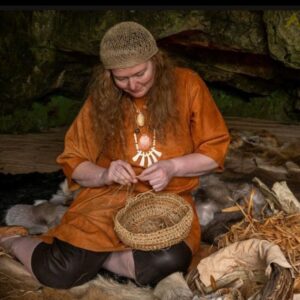
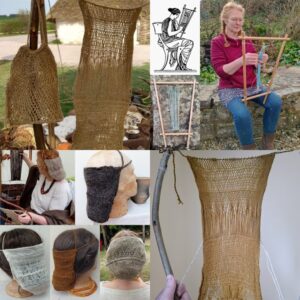
I recently had the delightful opportunity to Zoom chat with Experimental Archaeologist Sally Pointer at her home in the agricultural region of Herefordshire, England. Her Instagram account refers to her as a “self-described hedge botherer,” and my first question was just exactly what that is. Laughing, Sally said, “it refers to her habit of walking next to her local hedgerows and foraging for plants like nettles, mushrooms and the like.” Sally hails from Herefordshire, a regional rich with agricultural heritage and plenty of hedgerows for the aforementioned bothering.
With a bachelor’s degree from Dexter University in bot archaeology and Old English, a C & G certificate in training and education, as well as a Masters in Experimental Archaeology, Sally interprets living history at national heritage sites, The Time Team, museums, and schools throughout the United Kingdom. Old English language encompasses the period from early medieval to the end of the 14th century — the Norman period to the Romance period.
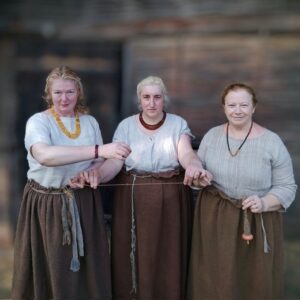
Various projects pique Sally’s interests. For instance, she developed a vertical, warp-weighted loom now used a living history sites throughout the United Kingdom. Also, upon closer examination of Venus figures, once thought to be naked females, are revealed to be garbed in finger-woven string skirts. Accurate interpretation of costumes for film companies and living history events is also important to her work.
Sally spent 10 years at the National Museum of Wales prior to freelancing in heritage education programs with her late husband, Gareth Riseborough. Sally has also authored several books and a number of publications on topics ranging from the history of cosmetology and herbs, costumes, and ancient crafts.
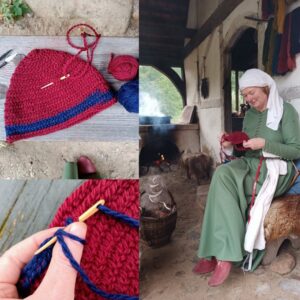
Sally’s expertise covers a broad date span from the paleolithic to World War II, with a heavy concentration in the more ancient paleolithic times. Utilizing her vast knowledge in textile use, she analyzes artifacts found and recreates how they would be used. Often, she will call on her previous work in a nearby similar area, say Denmark, and extrapolate possible uses. “And,” Sally wryly says, “a lot is educated guesswork.”
As part of the informal group Ancient Media, Sally teams with specialist crafters and archaeological researchers, and they consult for a broad range of entities like film producers and national heritage organizations to bring life to prehistory. Sally said, “We try to bring known parts to life and offer the best view of evidence we have at this point in time.”
Sally was recently at Cresswell Crags, a paleolithic site on the Nottingham border. A cave-filled gorge with steep cliffs on both sides, it has the oldest cave art in the United Kingdom and has been used from Neanderthals on up through 18th century witches.
On both YouTube and in person, Sally offers courses in Introduction to Prehistoric Textiles, nalbinding, soapmaking, garments, and costuming. On her website, Sally also offers dyed yarns, kits, soaps, bespoke caps, and even playful stuffed plague rats for your kitty’s pleasure.
When a crisis hits a community, survival will always eclipse crafts, so crafts will be the first skill to die off. For instance, a loom weight found in a village site conveys the information that the people there were stable and stationary enough to set up a loom. The loom weight, be it dried clay or stone, tells the archaeologist what style style loom was used. Examining a textile scrap under a microscope can reveal not only the fiber used, but also the method used to create the textile — nalbinding, looping, woven, sprang, or early knitting.
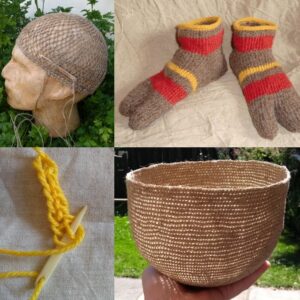
Knowing the approximate dates when people stopped relying on animal hides for clothing as agriculture arrived on the scene, can convey vital information. For instance, the arrangement of beads in a grave suggests the shape of a garment which has long ceased to exist.
The very first crop to be grown, surprisingly, was flax, even before grain crops like wheat. This implies that the demand for textiles was great. People started using plant fibers about 35,000 years ago. The oldest piece of textile found so far has been a 3-ply piece of string made from bark, constructed by a Neanderthal in France.
Right now, Sally shares that archaeologists “offer the best view of evidence we have at this point in time.” According to Sally, textile archaeology is a fast moving field, and the next ten years will prove quite exciting.
You can find more about Sally on Instagram @sallypointer, on Facebook, and at her website http://www.sallypointer.com